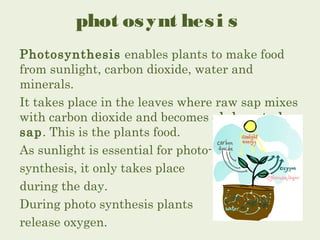Plants
- 1. Pl ant s
- 2. What i s a pl ant ? Plants are organisms which have roots, stems and leaves. Roots draw water and nutrients from the soil and up through the stem Stems also support the leaves. Leaves breathe and make the plant’s food.
- 3. Fl oweri ng pl ant s Flowering plants are the biggest group of plants. They can be either: •Gymnosperms which have small flowers, but no fruit. Instead their seeds are all together in cones. They are almost all trees, such as pine trees.
- 4. Fl oweri ng pl ant s OR •Angiosperms which have flowers and fruit. Chestnut trees and some grasses are angiosperms.
- 5. Non f l oweri ng pl ant s Non-flowering plants are the smallest group of plants. They need shade and moisture. Non- flowering plants include: Mosses- small plants which live on rocks, trees and the ground. Ferns- these are larger than mosses and have thick underground stems and big leaves.
- 6. Mos ses
- 7. Ferns
- 8. respi rat i on Plants are living things so to survive they have to breathe. They take in oxygen from the air and release carbon dioxide in an exchange of gases called respiration. Respiration takes places in the leaves day and night.
- 9. Pl ant nut ri t i on Plants obtain food in different ways to animals. They are autotrophs which means that they make their own food. They do this with sunlight, carbon dioxide, water and minerals from the soil.
- 10. Wat er and mi neral s Water and minerals are important for plant nutrition. In the soil, minerals dissolve in water which is then absorbed by plants through their roots. These nutrients are called raw sap and they travel up the stem to the leaves.
- 11. phot osynt hes i s Photosynthesis enables plants to make food from sunlight, carbon dioxide, water and minerals. It takes place in the leaves where raw sap mixes with carbon dioxide and becomes elaborated sap. This is the plants food. As sunlight is essential for photo-synthesis, it only takes place during the day. During photo synthesis plants release oxygen.
- 12. Carni vorous pl ant s http://www.tes.co.uk/teaching-resource/How-meat-eating-plants-catch-and-devour-











